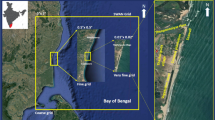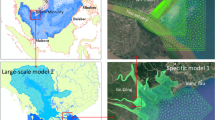Abstract
A comprehensive review of state of the art numerical modeling in the field of sea bed morphology during cyclonic events is of vital importance. In this study a high impact and devastating cyclone, Vardah (2016) is considered to understand the hydrodynamic conditions, whereas, the recent cyclone, Nivar (2020) is considered for investigating the morphodynamic changes along the continental shelf region off the state of Tamilnadu, India. Three different models are coupled intrinsically to simulate hydrodynamics of tides and surges, waves and morphodynamic conditions. Initially, the hydrodynamic and wave models are established and validated with field measurements for an extreme event. Then, morphodynamic model is coupled with validated wave and tide model. Furthermore, the validation of bed evolution is performed for two cases viz., currents only and combination of waves and currents. The combined effect of tides, waves and surges improves the morphodynamic predictions. The present paper emphasizes the spatial and temporal morphological changes along the radius of cyclone pertaining to the shelf region. It is observed that the impact of cyclone on morphodynamics is predominant upto half the radius of the cyclone along the coast and upto 25 m contour from the coast across the shelf region. In this study, the bed evolution and its rate of change at various locations along the coast and across the shelf are extensively discussed.












Similar content being viewed by others
References
Andrew TW, Turner RE (2014) Contribution of tropical cyclones to the sediment budget for coastal wetlands in Louisiana, USA. Landscape Ecol 29:1083–1094. https://doi.org/10.1007/s10980-014-0047-6
Bhaskaran PK, Rao AD, Murty T (2020) Tropical cyclone–induced storm surges and wind waves in the Bay of Bengal. Techn Disaster Risk Manag Mitig. https://doi.org/10.1002/9781119359203.ch17
Brown JM (2010) A comparison of WAM and SWAN under storm conditions in a shallow water application. Ocean Model 35(3):215–229
Engelund F, Hansen E (1967) A monograph on sediment transport in alluvial streams. TekniskForlag, Technical University of Denamark, Ostervolgade 10, Copenhagen, Denmark.
Exner FM (1925) Uber die Wechselwirkungzwischen Wasser und Geschiebe in Flussen (in German). Sitz Acad Wiss Wien Math Naturwiss Abt 2a 134:165–203
Guillou N, Chapalain G (2011) Effects of the coupling between TELEMAC 2D and TOMAWAC on SISYPHE modelling in the outer Seine estuary. Proceedings of the XVIIIth Telemac & Mascaret User Club 2011, 19–21 October 2011, EDF R&D, Chatou, pp 51–58
Hervouet JM, Van Haren L (1994) TELEMAC 2D Principal Note. Electricite de France Rapport HE 43/94/051/B, 87
Holland GJ (1980) An analytic model of the wind and pressure profiles in the hurricanes. Mon Weather Rev 108(8):1212–1218. https://doi.org/10.1175/1520-0493(1980)108%3c1212:AAMOTW%3e2.0.CO;2
Huang WP (2017) Modelling the effects of typhoons on morphological changes in the Estuary of Beinan, Taiwan. Continent Shelf Res 135:1–13. https://doi.org/10.1016/j.csr.2017.01.011
Lewis MJ, Palmer T, Hashemi R et al (2019) Wave-tide interaction modulates nearshore wave height. Ocean Dyn 69:367–384. https://doi.org/10.1007/s10236-018-01245-z
Liu W-C, Huang W-C (2020) Investigating typhoon-induced storm surge and waves in the coast of Taiwan using an integrally-coupled tide-surge-wave model. Ocean Eng 212:107571. https://doi.org/10.1016/j.oceaneng.2020.107571
Longuet-Higgins MS, Stewart RW (1964) Radiation stresses in water waves; a physical discussion, with applications. Deep Sea Res Ocean Abstracts 11(4):529–562. https://doi.org/10.1016/0011-7471(64)90001-4
Murty PLN, Sandhya KG, Prasad KB, Jose F, Gayathri R, Balakrishnan Nair TM, Srinivasa Kumar T, Shenoi SSC (2014) A coupled hydrodynamic modeling system for PHAILIN cyclone in the Bay of Bengal. Coast Eng 93:71–81. https://doi.org/10.1016/j.coastaleng.2014.08.006
Murty PLN, Siva Srinivas K, Pattabhi Rama Rao E et al (2020) Improved cyclonic wind fields over the Bay of Bengal and their application in storm surge and wave computations. Appl Ocean Res 95:102048. https://doi.org/10.1016/j.apor.2019.102048
Nandhakumar S, Kantharaj M, Vallam S (2022) Evaluation of total sediment transport model in the simulation of morphodynamics in two different hydrodynamic settings. J Waterway Port Coastal Ocean Eng 148(6):04022022. https://doi.org/10.1061/(ASCE)WW.1943-5460.0000727
Persson A, Grazzini F (2007) User guide to ECMWF forecast products Version 4.0. Meteorological Bulletin M, 3
Robins P, Davies A (2011) Application of TELEMAC-2D and SISYPHE to complex estuarine regions to inform future management decisions. Proceedings of the XVIIIth Telemac & Mascaret User Club 2011, 19–21 October 2011, EDF R&D, Chatou, pp 86–91
Sabique L, Annapurnaiah K, Nair TB, Srinivas K (2012) Contribution of Southern Indian Ocean swells on the wave heights in the Northern Indian Ocean A modeling study. Ocean Eng 43:113–120. https://doi.org/10.1016/j.oceaneng.2011.12.024
Saichenthur N, Murali K, and Sundar V (2022) Influence of horizontal eddy viscosity and bottom friction coefficients on morphodynamic evaluations. Journal of Hydro-Environment Research 40:102–15. ISSN 1570–6443. https://doi.org/10.1016/j.jher.2021.12.005
Samaras AG, Gaeta MG, Miquel AM, Archetti R (2016) High-resolution wave and hydrodynamics modelling in coastal areas: operational applications for coastal planning, decision support and assessment. Natl Hazards Earth Syst Sci 16(6):1499–1518. https://doi.org/10.5194/nhess-16-1499-2016
Samiksha V, Vethamony P, Antony C, Bhaskaran P, Nair B (2017) Wave–current interaction during Hudhud cyclone in the Bay of Bengal. Nat Hazards Earth Syst Sci 17:2059–2074. https://doi.org/10.5194/nhess-17-2059-2017
Selvaraj R, SA S, Vallam S (2022) Hydrodynamic modelling of storm surge with modified wind fields along the east coast of India. Mar Geod 45(5):557–576. https://doi.org/10.1080/01490419.2022.2082603
Silva PA, Bertin X, Oliveira A, Fortunato A (2009) Intercomparison of sediment transport computations in current and combined wave and current conditions. J Coast Res SI56:559–563
Singh OP (2007) Long-term trends in the frequency of severe cyclones of Bay of Bengal: observations and simulations. Mausam 58(1):59–66. https://doi.org/10.54302/mausam.v58i1.1131
Srinivasa Kumar T, Murty PLN, Pradeep Kumar M et al (2015) Modelling storm surge and its associated inland inundation extent due to very severe cyclonic storm Phailin. Mar Geod 38:345–360. https://doi.org/10.1080/01490419.2015.1053640
Sundar V, Murali K, Sukanya R, Arun Rajasekar A (2021) Tidal inlet morphodynamics through numerical prediction and measurements. Mar Georesour Geotechnol. https://doi.org/10.1080/1064119X.2021.1992548
Van Rijn LC, Walstra DJR, Grasmeijer B, Sutherland J, Pan S (2003) Sierra JP (2003) The predictability of cross-shore bed evolution of sandy beaches at the time scale of storms and seasons using process-based Profile models. Coast Eng 47(3):295–327. https://doi.org/10.1016/S0378-3839(02)00120-5
Vincent CE, Stolk A, Porter CFC (1998) Sand suspension and transport on the Middelkerke Bank (southern North Sea) by storms and tidal currents. Mar Geol 150(1–4):113–129. https://doi.org/10.1016/S0025-3227(98)00048-6
Wiese A, Stanev E, Koch W, Behrens A, Geyer B, Staneva J (2019) The impact of the two-way coupling between wind wave and atmospheric models on the lower atmosphere over the North Sea. Atmosphere 10:386. https://doi.org/10.3390/atmos10070386
Wolf J (2009) Coastal flooding: impacts of coupled wave-surge-tide models. Nat Hazards 49(2):241–260
Woodcock F, Greenslade DM (2007) Consensus of numerical model forecasts of significant wave heights. Weather Forecast 22(4):792–803. https://doi.org/10.1175/WAF1021.1
Wu L, Breivik O, Rutgersson A (2019) Ocean-wave-atmosphere interaction processes in a fully coupled modeling system. J Adv Model Earth Syst. https://doi.org/10.1029/2019MS001761
Acknowledgements
Indian National Centre for Ocean Information Services (INCOIS)—Earth System Science Organization (ESSO), MoES, Govt. of India, is acknowledged for their data support.
Funding
This work is supported by the Department of Science and Technology, India Grant No. DST/CCP/CoE/141/2018C under SPLICE – Climate Change Program.
Author information
Authors and Affiliations
Corresponding author
Ethics declarations
Conflict of interest
The authors have no competing interests to declare that are relevant to the content of this article.
Additional information
Publisher's Note
Springer Nature remains neutral with regard to jurisdictional claims in published maps and institutional affiliations.
Rights and permissions
Springer Nature or its licensor (e.g. a society or other partner) holds exclusive rights to this article under a publishing agreement with the author(s) or other rightsholder(s); author self-archiving of the accepted manuscript version of this article is solely governed by the terms of such publishing agreement and applicable law.
About this article
Cite this article
Rohini, S., Sannasiraj, S.A. & Sundar, V. Investigation of morphodynamic evolution in a shelf region of Bay of Bengal under extreme conditions. Nat Hazards 116, 3043–3062 (2023). https://doi.org/10.1007/s11069-022-05797-8
Received:
Accepted:
Published:
Issue Date:
DOI: https://doi.org/10.1007/s11069-022-05797-8




